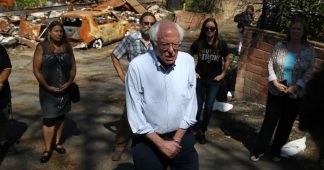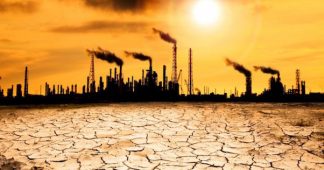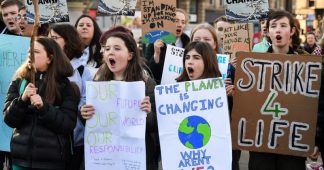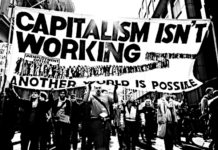Aviva Chomsky reports on the complexities of labor’s response to the Green New Deal and little-known divisions over the plan within the environmental movement.
By Aviva Chomsky
August 12, 2019
When it comes to heat, extreme weather, wildfires, and melting glaciers, the planet is now in what the media increasingly refers to as “record” territory, as climate change’s momentum outpaces predictions. In such a situation, in a country whose president and administration seem hell-bent on doing everything they conceivably can to make matters worse, the Green New Deal (GND) seems to offer at least a modest opening to a path forward.
You know, the resolution introduced this February in the House of Representatives by Alexandria Ocasio-Cortez (D-NY) and Edward Markey (D-MA). Unsurprisingly, the proposal has been roundly attacked by the right. But it’s stirred up some controversy on the left as well. You might imagine that labor unions and environmental organizations would be wholeheartedly for a massive federal investment in good jobs and a just transition away from fossil fuels. But does organized labor actually support or oppose the Green New Deal? What about environmental organizations? If you’re not even sure how to answer such questions, you’re not alone.
That 14-page resolution calls for “a new national, social, industrial, and economic mobilization on a scale not seen since World War II and the New Deal era.” Its purpose: to reduce U.S. carbon emissions to net zero within a decade, while guaranteeing significant numbers of new jobs and social welfare to American workers. Read it and you’ll find that it actually attempts to overcome historical divisions between the American labor and environmental movements by linking a call for good jobs and worker protection to obvious and much-needed environmental goals.
In the process, the GND proposal goes impressively far beyond the modest goals of the Paris Climate Accords and other international agreements. It supports specific, enforceable targets for bringing climate change under control, while drawing clear connections between social, labor, and environmental rights. Acknowledging in blunt terms the urgency of making systemic change on a rapidly warming planet, it calls for the kind of national mobilization Americans haven’t experienced since the end of the Second World War. Described that way, it sounds like something both the labor and environmental movements would naturally support without a second thought. There is, however, both a history of mistrust and real disagreement over issues, which both movements are now grappling with. And the media is doing its part by exaggerating labor’s opposition to the proposal, while ignoring what environmental organizations have to say.
One Green New Deal controversy focuses on the future role of fossil fuels in that plan. A number of environmental organizations believe that such energy sources have no place in our future, that they need to stay in the ground, period. They cite climate science and the urgent need to move rapidly and drastically to eliminate carbon emissions as the basis for such a conclusion. As it happens, the Green New Deal avoids directly challenging the fossil-fuel industry. In fact, it doesn’t even use the term “fossil fuels.”
From another perspective, some unions hope that new technologies like carbon capture, utilization, and storage (CCUS) will make those fuels more efficient and far cleaner. If the addition of carbon to the atmosphere could be reduced significantly or offset in some fashion, while humanity still burned natural gas, oil, or even coal, they say, jobs in those sectors could be preserved. And the unions have other concerns as well. They tend, for instance, to look skeptically on the GND’s promises of a “just transition” for displaced fossil-fuel workers like coal miners, given the devastation that has fallen on workers and their communities when industries have shut down in the past. They also fear that, without accompanying trade protections, polluting industries will simply export their emissions rather than reduce them.
Being more of a statement of purpose than an elaborated plan, the Green New Deal is short on both detail and answers when it comes to such issues. The actual roadmap to achieving its goals, the proposal states, “must be developed through transparent and inclusive consultation, collaboration, and partnership with frontline and vulnerable communities, labor unions, worker cooperatives, civil society groups, academia, and businesses.” Both unions and environmental organizations are already mobilizing to make sure their voices are part of the process.
The right wing was quick to mockingly publicize the Green New Deal not just as thoroughly unrealistic but as utterly un-American. Under the circumstances, perhaps it’s not surprising that a recent poll found 69 percent of Republicans but only 36 percent of Democrats had heard “a lot” about it. Similarly, 80 percent of Republicans already “strongly opposed” it, while only 46 percent of Democrats strongly supported it. And 40 percent of those polled said that they had heard “mostly negative” things about it, while only 14 percent had heard “mostly positive” things. One reason for this disparity: Fox News has devoted more time to the topic than any other television news outlet. And President Trump naturally pitched in, tweeting that the GND would eliminate “Planes, Cars, Cows, Oil, Gas & the Military.”
I think it is very important for the Democrats to press forward with their Green New Deal. It would be great for the so-called “Carbon Footprint” to permanently eliminate all Planes, Cars, Cows, Oil, Gas & the Military – even if no other country would do the same. Brilliant!
— Donald J. Trump (@realDonaldTrump) February 9, 2019
Such claims, however fantastical, have already spread widely. But even the mainstream media has tended to play up the negative.
Both right-wing and mainstream media outlets have promoted the idea that unions are in firm opposition to the Green New Deal, frequently exaggerating and distorting the nature of what opposition there is. As for the concerns of environmentalists, readers would largely have to follow radical online publications or search out the websites of green organizations.
Media & Labor Movement
The Washington Examiner, Fox News, and other right-wing outlets have waxed gleeful every time representatives of organized labor, including Richard Trumka, president of the AFL-CIO, have critiqued or expressed reservations about the Green New Deal, a topic on which the rest of the mainstream media has also run stories. Labor’s position is, however, significantly more complicated than any of them have acknowledged.
In an hour-long interview at the Economic Club of Washington in April — reported in the Examiner under the headline “AFL-CIO Opposes Green New Deal” — Trumka actually devoted less than 30 seconds to responding to a question on the topic. Asked if he supported the GND, he replied “Not as currently written… We weren’t part of the process, and so the workers’ interest really wasn’t completely figured into it. So we would want a whole lot of changes made so that workers and our jobs are protected in the process.” Not exactly a wholesale rejection.
His brief reaction echoed a March letter from the AFL-CIO Energy Committee to Ocasio-Cortez and Markey signed by the presidents of the United Mine Workers and the International Brotherhood of Electrical Workers. Among other things, it protested the absence of a labor voice in drafting the proposal. It also focused on the potential loss of jobs, as well as the fact that the GND was “not rooted in an engineering-based approach” to climate change, reflecting union hopes that improved technologies might allow the U.S. to meet climate goals while still extracting and burning fossil fuels (and so preserving jobs in that sector of the economy).
Wyoming Republican Sen. John Barrasso, a long-time ally of the coal, oil, and gas industries, a climate-change denier, and a reliably anti-union vote in Congress, first noted the existence of the letter in a tweet headlined: “The @AFLCIO, which represents 12.5 million workers & includes 55 labor unions, slams the #GreenNewDeal.”
The @AFLCIO, which represents 12.5 million workers & includes 55 labor unions, slams the #GreenNewDeal in a letter to @SenMarkey & @AOC:
“We will not accept proposals that could cause immediate harm to millions of our members and their families.”
I agree with the AFL-CIO. pic.twitter.com/pEVhr9Ricr
— Sen. John Barrasso (@SenJohnBarrasso) March 11, 2019
Both the right wing and the mainstream media largely agreed with his interpretation. The Washington Post, for instance, headlined its article “AFL-CIO Criticizes the Green New Deal,” while the Examiner called the federation the “latest opponent” of the resolution.
Two facts were, however, missing in action in this reporting. First, the members of the AFL-CIO Energy Committee come from only eight unions, most of them deeply dependent on the fossil-fuel industry. In that sense, it doesn’t represent the federation as a whole. Second, the letter itself was more nuanced than the media coverage suggested and even its signers were far from unanimous. True, one of them, Terry O’Sullivan, president of the Laborers International Union of North America, claimed to be unalterably opposed to the GND, saying it was “exactly how not to” address infrastructure and climate change. Linking them, he wrote, would cause “social and economic devastation.” In contrast, in an article ignored by the media and headlined “Labor Champions a Green New Deal,” another signer, United Steelworkers President Leo Gerard, suggested that the letter actually supported the GND.
The Energy Committee’s letter laid out its own vision of how to address the coming crisis through:
“[the] development and deployment of technologies like solar, wind, nuclear, hydroelectric, carbon capture and utilization, battery storage, and high speed rail that limit or eliminate carbon emissions. We know that the increase in natural gas production has lowered emissions in the power sector and provided a new source of construction and manufacturing jobs. We must invest in energy efficiency in the industrial and commercial sectors, retrofits and upgrades to schools and public buildings, and to make our communities safe and resilient. All of these investments must be paired with strong labor and procurement standards to grow family-sustaining, middle class union jobs.”
Much of this sounds like it’s aligned with the language of the GND, which also calls for increased efficiency, retrofits, upgrades, and labor guarantees. The differences may seem subtle, but are worth mentioning. The Energy Committee emphasizes investment in new carbon capture and storage technology, while the GND advocates only “proven low-tech solutions that increase soil carbon storage, such as land preservation and afforestation.” For obvious reasons, CCUS is the preferred path of the fossil-fuel industry itself: it’s an aspirational technology that will require massive federal investment in big energy and holds out the promise (however illusory) that fossil fuels can continue to be extracted and burned. Many environmental organizations argue that its development is not just a gift to fossil-fuel companies, but a pie-in-the-sky distraction from the real work of ending the use of oil, coal, and natural gas.
The Energy Committee’s letter also advocated increasing the use of natural gas as part of a path to lowering carbon emissions — and it’s true that natural gas does emit less carbon than burning either coal or oil. In fact, until recently, the shift from coal- to natural-gas-fired power plants played a role in slightly lowering U.S. greenhouse gas emissions. Still, natural gas is a fossil fuel, and the more we burn, the more we contribute to climate change. It in no way falls into the GND’s category of “clean, renewable, and zero-emission energy sources.” And keep in mind that, even during a decade of reductions, the United States still emitted far more greenhouse gases per capita than most other countries and, in the last two years, its carbon dioxide emissions have begun to rise again. Our per capita emissions are still way above those of, say, Europe or Japan. Shifting to a slightly cleaner fossil fuel while continuing to burn so much carbon does little to avert catastrophic climate change.
These disputes are real. Nevertheless, the right wing caricatured the AFL-CIO response to paint the GND as an outlandish, anti-worker proposal.
From the left, the environmental organization Friends of the Earth also caricatured the AFL-CIO stance, writing: “With the energy committee’s position, the AFL joins climate deniers like the Koch brothers, the Republican Party, and Big Oil. We encourage the AFL and other unions within it to rethink this position.” Such language only exacerbates any labor-environmental divide, while ignoring union concerns that workers in affected industries will be paying the true price for lowering carbon emissions.
Friends of the Earth could have focused instead on Richard Trumka’s words at the 2018 Global Climate Action Summit. The Federation, he insisted, does not question climate science.
“I learned something about science in the mine. When the boss told us to ignore the deadly hazards of the job… that sagging timber over our heads… that Black Lung cough… science told us the truth. And today, again, science tells us the truth: climate change threatens our workers, our jobs, and our economy.”
He then asked one question: “Does your plan for fighting climate change ask more from sick, retired coal miners than it does from you and your family? If it does, then you need to think again.”
Or as Sara Nelson, president of the Association of Flight Attendants and a strong Green New Deal supporter, put it:
“The skepticism really comes from a place of generally being opposed to something that they believe is going to be an attack on their jobs, their livelihoods, and their communities… We have to do things like show communities that have been hurt that we actually mean what we say when we say ‘leave no worker behind.’”
For the unions, an emphasis on trade is also critical from both an environmental and a labor perspective. United Steelworkers President Gerard elaborated:
“The USW has aggressively demanded that climate policies include strong trade measures to ensure American jobs in energy-intensive and trade-exposed industries are not decimated by U.S. corporations evading pollution-control regulations by shipping factories to countries that ignore pollution.”
Why Labor Hesitates: A Tangled History
While a skeptic could read Gerard’s stance on trade as no more than a narrow self-interest in preserving jobs in the face of a planetary crisis, it’s also a crucial issue purely from a climate-change perspective. In addition to the shift from coal to natural gas, another factor in the slight decline in U.S. carbon dioxide emissions until recently was deindustrialization and the outsourcing of industrial production to Mexico, China, or Vietnam, which represents a thoroughly illusory reduction in carbon emissions. The atmosphere, of course, doesn’t care whether a factory is located in the United States or China, since total global emissions are what’s warming our planet.
While the AFL-CIO leadership has been cautious about the Green New Deal proposal, some unions have enthusiastically hailed it, among them public and service sector ones. With its 2 million members, the Service Employees International Union, not currently affiliated with the AFL-CIO, signed on wholeheartedly at its convention in early June. The 50,000-strong Association of Flight Attendants soon seconded that position as its president, Sara Nelson, explained that, in her industry, “it’s not the solutions to climate change that kill jobs. Climate change itself is the job killer,” since extreme weather and increased turbulence are grounding more flights and making air travel more dangerous.
Maine’s state federation and a number of labor councils followed suit, as have quite a few union locals. While the International Brotherhood of Electrical Workers, for instance, has been reluctant to endorse the Green New Deal, at least one of its locals has signed on. “We’re all about green jobs,” declared Lou Antonellis, the business manager of local 103 in Boston. “We’ve been promoting green technology for a long time.” (For a fuller list of labor endorsements, click here.)
There is a context — think of it as a deeply tangled history — that lies behind the complexity of labor’s response to the Green New Deal. As a start, labor in the United States has rarely spoken with a unified voice. In addition, the union movement is now distinctly on the defensive. The unionized share of the labor force has fallen from a high of 35 percent in the 1950s to less than 11 percent today, thanks to a combination of deindustrialization, automation, cutbacks, attacks on the public sector, and a virulent corporate backlash against unions that began in the 1970s. Mass production powerhouses like the auto workers, steel workers, and miners — all in sectors in which a fossil-fuel-free future is challenging to imagine — have been hit the hardest, a situation that provides some context for their suspicions about climate-change proposals.
The weak position of organized labor in the United States also contributes to the AFL-CIO’s opposition to the notion that the planet’s biggest polluting states need to make the biggest reductions. As a result, its stance on international climate agreements lags well behind the international union movement. The AFL-CIO, for instance, opposed the 1997 Kyoto Protocol because it required greater reductions from the biggest polluters and, since then, has consistently supported the U.S. government position that wealthy countries should not be required to meet emissions reductions standards unless poor countries do, too.
Environmental Organizations & the Green New Deal
You wouldn’t know it from the media coverage, but environmental organizations are also divided on the Green New Deal. Many of them feel the proposal is too weak. Its language, they say, still allows for fossil-fuel extraction, use, and export, and for the expansion of nuclear energy.
The GND, after all, aims not at zero carbon emissions, but at “net-zero.” In translation, that means carbon dioxide emissions could continue as long as some kind of offset system was implemented to compensate for them. Even as the AFL-CIO Energy Committee argues that net-zero goes too far, many environmental organizations critique the GND’s unwillingness to opt for “zero emissions.” In fact, even zero emissions raises red flags for some environmentalists, who point out that nuclear power, despite its non-renewable nature and devastating potential environmental consequences, remains a zero-emissions form of energy production. Instead, many environmental organizations advocate that we move to energy sources that are both 100 percent renewable and zero emissions.
Like the unions, such radical environmental organizations complained that they were left out of the discussion leading up to the Green New Deal proposal and had no chance to push for moving more quickly to 100 percent renewables and what they call “100 percent decarbonization.” While they, like the unions, call for a “just transition,” their focus tends to be on indigenous and other front-line communities affected by fossil-fuel extraction as well as workers in those industries. Unlike the labor critiques, this environmental position has gotten scant attention in the mainstream media.
Many of the 600 signers of a letter outlining the radical environmental critique of the GND were small, local or faith-based organizations. Some of the large mainstream environmental groups like the Sierra Club, the Natural Resources Defense Council, and the Environmental Defense Fund were conspicuously absent from the signatories. Others like Greenpeace, Friends of the Earth, 350.org, the Sunrise Movement, the Rainforest Action Network, the Indigenous Environmental Network, and Amazon Watch did, however, sign on. So, notably, did the Labor Network for Sustainability, the most radical voice in the labor movement working in support of climate-change action.
The Indigenous Environmental Network wrote:
“We remain concerned that unless some changes are made to the resolution, the Green New Deal will leave incentives by industries and governments to continue causing harm to Indigenous communities. Furthermore, as our communities who live on the frontline of the climate crisis have been saying for generations, the most impactful and direct way to address the problem is to keep fossil fuels in the ground. We can no longer leave any options for the fossil fuel industry to determine the economic and energy future of this country. And until the Green New Deal can be explicit in this demand as well as closing the loop on harmful incentives, we cannot fully endorse the resolution.”
Other organizations like 350.org signed on to the Green New Deal despite reservations. Greenpeace lauded it, while cautioning that “the oil, gas, and coal industry will fight this tooth and nail while continuing to dump pollution into our atmosphere. In order to get us to the green future we want, federal legislation MUST also halt any major oil, gas, and coal expansion projects like pipelines and new drilling.”
The Future of the GND
Despite challenges from parts of both the labor and the environmental movements, which its sponsors had undoubtedly hoped would be among its strongest supporters, Markey and Ocasio-Cortez’s Green New Deal resolution has gone a remarkably long way toward putting a genuine discussion of what an effective and just climate policy might look like in the public arena for the first time. For grassroots environmental organizations, labor unions, nongovernmental outfits, Congress, and the media, as heat waves multiply, the Arctic burns, and extreme weather of every sort becomes everyday news, the question of what is to be done is finally emerging as a subject to contend with, even in the 2020 presidential election campaign. In policy discussions, the urgency of the climate crisis is being acknowledged for the first time and the question of how to radically lower carbon emissions while prioritizing social justice is coming to the fore. These are exactly the debates that are needed in this all-hands-on-deck moment when human civilization is itself, for the first time in our history, in question.
Aviva Chomsky is professor of history and coordinator of Latin American studies at Salem State University in Massachusetts and a TomDispatch regular. Her most recent book is “Undocumented: How Immigration Became Illegal.”
This article is from TomDispatch.com.
Published at https://consortiumnews.com/2019/08/12/labor-and-environment-movements-complex-stance-on-green-new-deal/











